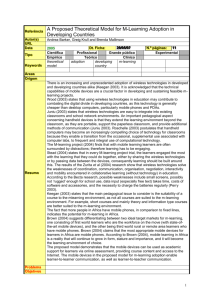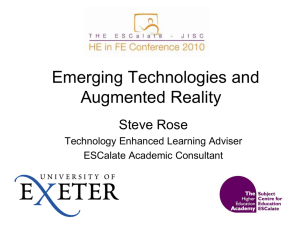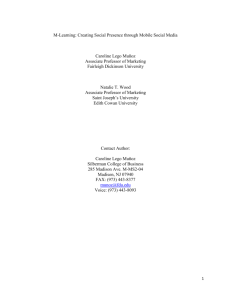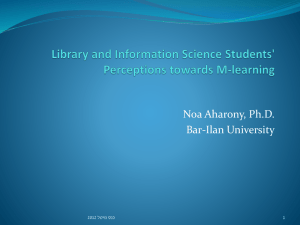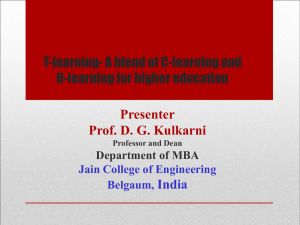M-LEARNING BY: SITI NABILAH BT AHMAD SANUSI (98847) In this
advertisement
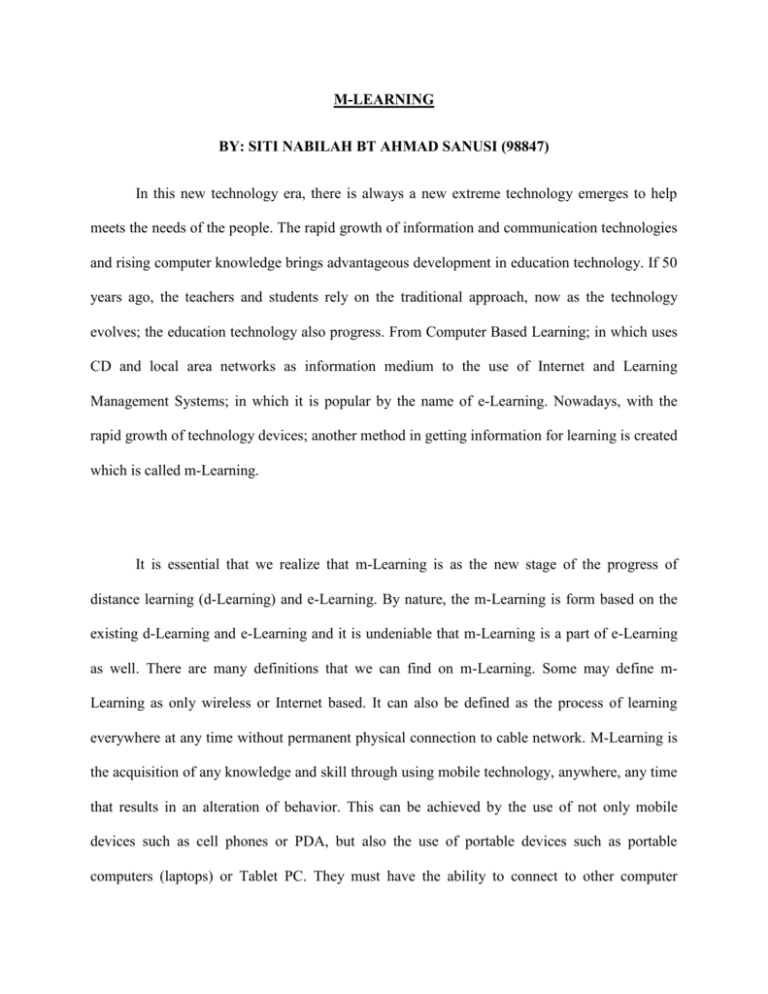
M-LEARNING BY: SITI NABILAH BT AHMAD SANUSI (98847) In this new technology era, there is always a new extreme technology emerges to help meets the needs of the people. The rapid growth of information and communication technologies and rising computer knowledge brings advantageous development in education technology. If 50 years ago, the teachers and students rely on the traditional approach, now as the technology evolves; the education technology also progress. From Computer Based Learning; in which uses CD and local area networks as information medium to the use of Internet and Learning Management Systems; in which it is popular by the name of e-Learning. Nowadays, with the rapid growth of technology devices; another method in getting information for learning is created which is called m-Learning. It is essential that we realize that m-Learning is as the new stage of the progress of distance learning (d-Learning) and e-Learning. By nature, the m-Learning is form based on the existing d-Learning and e-Learning and it is undeniable that m-Learning is a part of e-Learning as well. There are many definitions that we can find on m-Learning. Some may define mLearning as only wireless or Internet based. It can also be defined as the process of learning everywhere at any time without permanent physical connection to cable network. M-Learning is the acquisition of any knowledge and skill through using mobile technology, anywhere, any time that results in an alteration of behavior. This can be achieved by the use of not only mobile devices such as cell phones or PDA, but also the use of portable devices such as portable computers (laptops) or Tablet PC. They must have the ability to connect to other computer devices, to present educational information and to realize bilateral information exchange between the students and the teacher. M-Learning is convenient in that it is accessible from virtually everywhere. Before we discuss further on m-Learning, I like to share a few general knowledge on what are the example of mobile devices and its communication technologies that helps in achieving the process of mobile learning. For your information, they are a lot of mobile devices which vary significantly in their abilities, sizes and prices but the common ability which united them in their mobility and possibility to make a wireless connection – in which this characteristic is crucial in mobile learning. M-Learning cannot be achieved if there aren’t any wireless connections. The main types of mobile devices used in the education process are notebook computers, tablet PC, personal digital assistant (PDA), cellular phones and Smartphones. As noted earlier, all of these mobile devices vary from each other. Notebooks computers have such abilities as desktop personal computers but they are smaller sizes than desktop and can support wireless communication. Unfortunately the prices are the highest among all mobile devices that are mentioned earlier. Next is tablet PC which is one of the newest mobile devices. They also have full range of abilities as personal computers. They are also relatively expensive. As for PDA, they are small sizes and have significant processor power. They support more than 65000 colours, recognize handwritten text and can play different types of multimedia files. The main operating systems used are Palm and Microsoft Pocket PC. The forth mobile devices that is used for m-Learning is our very own cellular phones which from the higher class that can be used to access Internet either via WAP or GPRS technologies. This device has its disadvantages which are low memory capacity and low data transfer rate. But the prices are continuously decreased. Lastly is Smart phones which are hybrid devices that combine the abilities of cellular phones and PDA. They have smaller size than PDA but bigger than cellular phones. They use Symbian, Windows Mobile or other operating system. They have potentially to be successfully used in the mobile multimedia education as they also have Internet browser. Thus, the term ‘mobile technology’ is not only limited to handphones or cellular phones that we use for communication but refers to any devices that designed to provide access to information in any location or while on the move. Every mobile device that is used in m-Learning is supported by various communication technologies. These technologies vary enormously as well as data transmission range and their range. The first communication technology is Global System for Mobile Communication (GSM) which is one of the leading digital cellular systems. GSM has become the world’s most widely used mobile system in use in over 100 countries. It provides integrated voice mail, high-speed data, fax, paging and short message services capabilities, as well as secure communication. It offers the best voice quality of any current digital wireless standard. Next is Wireless Application Protocol (WAP) which is a free, unlicensed protocol for wireless communications. It makes possible creation of advanced communications services and access to Internet pages from cellular phones. Then, General Packet Radio Service (GPRS) which is packet-linked technology that enables high-speed wireless Internet and other data communications. GPRS provides about four times greater speed than conventional GSM systems. Another communication technology that involves is Bluetooth wires technology which is a short-range radio technology. It makes it possible to transmit signals over short distances between telephones, computers and other devices and thereby simplify communication and synchronization between devices. Other than that is IEEE 802.11 which is a type of radio technology used for wireless local networks (WLANs) or it is famous with the name of Wi-Fi. Wi-Fi is composed of several standard operating in different radio frequencies. Lastly is Infrared Data Association (IrDA) which is a suite of protocols for infrared (IR) exchange of data between two devices, up to 1 to 2 meters apart. Examples of devices that use this protocol are Smart phones, PDAs, printers and laptop computers. After understanding on the concept of m-Learning and gaining information on which mobile devices that can be used in m-Learning; we will discussed on the advantages of it. As we all know, m-Learning is a new method in gaining information and serves as the new methodology of learning. It serves many kinds of benefits to the user; but I will only discuss the main four advantages of m-Learning which are access, context, collaboration and appeal. The most obvious advantage of an m-Learning is the ability to access information wherever and whenever we want via our mobile devices. This includes a businessman on the way for a meeting, a student sitting on a public transport, lecturer access information while in a lecture and the list of examples goes on. Nowadays, speeds are very important in our life. As a saying goes, time is money and in the real life, whoever grabs the chance faster, he will gain the best. Thus, m-Learning provides a platform for people to access information faster and more effectively if they are to increase their employability, business success, personal fulfillment and social development. It provides people with opportunity to retrieve information where it previously has been impossible. It is not limited to the time and location as long as we can connect to the Internet with our mobile devices in which is relatively inexpensive compared to desktop computers. The next advantage is information technology can provide context through problem- solving activities in simulated authentic environment where the learner can experiment, make mistakes and learn in which it is considered important in achieving meaningful learning. Real time scenario and problem based learning can be conducted in the application environment through the use of mobile devices. The third advantage of m-Learning is it allows collaboration to take place regardless of physical location, in real time and to include text and rich media as well as voice. The term collaboration refers to an approach which emphasizes in the importance of intrinsic learning through social interactions. This approach will results in learners being more engaged and helps to develop personal intellectual structures that foster a deeper understanding of the content at hand. By using m-learning, collaborative environment can be international because as wireless protocols become more common and accessible; learners will be able to participate in the international Internet communication. Lastly, m-Learning are able to appeal to a learner for his/her learning process. A research carries the result that majority of m-Learning target audiences lack basic skills because they are not interested in taking part in traditional education and training. However, m-Learning’s ability to learn whenever and wherever is required results the students learn without being self-conscious of the lack of ability. Hence, this will increase the students’ motivation. On the other hand, there are also some disadvantages that we can identify in which there are some problems that occur when using portable devices for m-Learning. The problems are small PDA and cellular phones screen sizes limit the abilities to display information, the small keyboard of PDA and cellular phones make the input of the information difficult, PDA and mobile phones have limited memory size, there is necessary to regularly charge the mobile devices’ battery, it is impossible to use applications developed for desktop PC in mobile devices, it is difficult to use multimedia elements such as video in cellular phones and finally the prices for wireless communications are still high. However, there are potential technological solutions which have the abilities to solve these problems. In conclusion, the change from e-Learning to m-Learning will excite the change in the educational paradigm. The educational process will become more flexible and will fulfill to the needs of lifelong learning. As mentioned earlier, as we progress through the 21 st century, the hectic pace of our life increase, society will need to find faster and more inventive ways to utilize previously unproductive time. Lifelong learning will be essential for maintaining a competitive advantage in the global economy, for personal growth, and for simply functioning efficiently in an increasingly technological environment. Thus, m-Learning can provides all of the above and will be the key factors in our successful development and our ability to function in the 21 st century. This is because m-Learning provides access to learning during previously unproductive times, allows more flexible and immediate collaborative options, allows controlled learning in contextual situations and provides greater options for teachers to observe and assist in independent learning.


